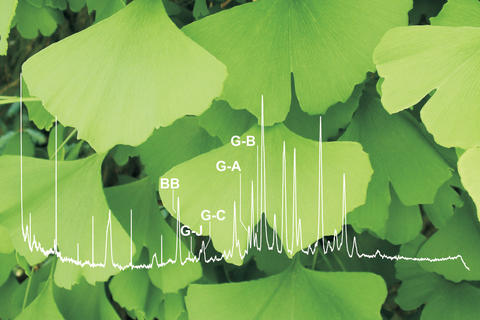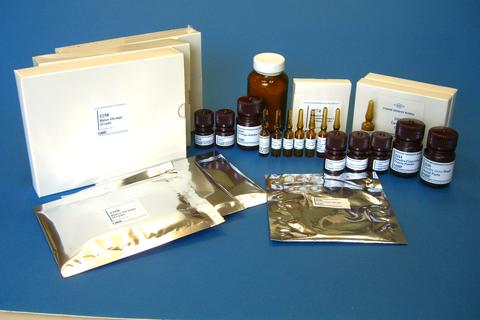Summary

As part of a multi-year interagency agreement among the National Institute of Standards and Technology (NIST), the National Institutes of Health's Office of Dietary Supplements (NIH/ODS), the Food and Drug Administration (FDA) Center for Food Safety and Applied Nutrition (CFSAN), and the FDA Center for Drug Evaluation and Research (CDER), NIST is developing Standard Reference Materials (SRMs) for botanical dietary supplements.
SRMs with assigned values for concentrations of active and/or marker compounds, pesticides, and toxic elements are being produced to assist in the verification of manufacturers' label claims and for use in quality control during the manufacturing process in support of the Good Manufacturing Practices released by the FDA in 2007.
Description

Many consumers believe that botanical dietary supplements will improve their health and that these "natural" remedies are both effective and free from the side effects that may occur with other medications. There are occasional reports of inaccurate labeling, adulteration, contamination (with pesticides, heavy metals, or toxic botanicals), and drug interactions. Congress recognized the lack of publicly available, validated analytical methods for dietary supplements – and a lack of reference materials for validation of analytical methods – in 1994 when the Dietary Supplement Health and Education Act (DSHEA) was enacted. As part of DSHEA, NIH/ODS was directed to fund development of analytical methods and reference materials for dietary supplements. NIST's dietary supplement program began in 2001 as a collaborative effort between NIST and NIH/ODS to underpin the then-anticipated GMPs. Subparts E and J of the GMPs require manufacturers to establish specifications for identity, purity, strength, and composition; to set limits on contaminants and adulterants for every ingredient in their products; and to analyze both "materials in process" and finished products to determine whether specifications are met. The validity of analytical methods must be verified and then routinely used for monitoring against the manufacturer's specifications. Thus, the SRMs can be used both to demonstrate that a method is appropriate for its intended use and as a quality control material when demonstrating that specifications are met, ultimately reducing public health risks that may be associated with these products.
Major Accomplishments
- More than 20 natural-matrix SRMs have been produced with more in progress.
- Analytical methods have been developed for the measurement of citrus alkaloids, flavonoids, catechins, phytosterols, xanthines, and organic acids.
- Certificates of Analysis for these materials can be found here or by clicking the SRM numbers in the list to the right.
ADDITIONAL TECHNICAL DETAILS
In most cases, these SRMs are provided as suites of materials (plant, extract, finished product) that represent different analytical challenges. The constituents for which values are assigned are also listed. The constituents in all of these materials have been determined by multiple independent methods with measurements performed by NIST and collaborating laboratories. The methods utilized different sample extraction and cleanup steps in addition to different instrumental analytical techniques and approaches to quantification. These materials are provided primarily for use in method development and as control materials to support the measurement of these constituents in other similar products.
Suites of materials based on black cohosh, soy, kudzu, and red clover are currently in progress.
GOALS
- Increase the types and availability of botanical dietary supplement SRMs to meet the needs of analytical laboratories, manufacturers, and regulators
- Develop methods of analysis for these materials
- Enable the establishment of a link to label information on botanical dietary supplements
- Provide calibration solutions for selected constituents in the botanical products
ASSOCIATED PRODUCT(S)
| SRM | Description |
| 3232 | Kelp Powder (Thallus laminariae ) |
| 3235 | Soy Milk |
| 3246 | Ginkgo biloba (Leaves) |
| 3247 | Ginkgo biloba (Extract) |
| 3248 | Ginkgo-Containing Tablets |
| 3250 | Saw Palmetto (Serenoa repens ) Fruit |
| 3251 | Saw Palmetto (Serenoa repen s) Extract |
| 3254 | Green Tea (Camellia sinensis )Leaves |
| 3255 | Green Tea (Camellia sinensis ) Extract |
| 3256 | Green Tea-Containing Solid Oral Dosage Form |
| 3262 | St. John's Wort (Hypericum perforatum) Aerial Parts |
| 3268 | Kudzu (Pueraria montana ) Extract |
| 3275 | Omega-3 and Omega-6 Fatty Acids in Fish Oil |
| 3279 | Chromium Dietary Supplement |
| 3281 | Cranberry (Fruit) |
| 3282 | Low-Calorie Cranberry Juice Cocktail |
| 3283 | Cranberry Extract |
| 3284 | Cranberry-Containing Solid Oral Dosage Form |
| 3285 | Mixed-Berry Containing Solid Oral Dosage Form |
| 3289 | Multivitamin Tablets |
| 3291 | Bilberry Extract |
| 3294 | Multielement Tablets |
| 3299 | Ground Turmeric (Curcuma longa L. ) Rhizome |
| 3300 | Curcumin Extract of Turmeric (Curcuma long L.) Rhizome |
| 3384 | Ground Asian Ginseng (Panax ginseng C.A. Meyer) Rhizome |
| 3385 | Asian Ginseng (Panax ginseng ) Extract |
| 3389 | Ginsenosides Calibration Solutions |
| 3398 | Ginger (Zingiber officinale) Rhizome |
| 3530 | Iodized Table Salt (Iodide) |
| 8037 | Krill Oil |
| 8183 | Omega-3 and Omega-6 Fatty Acids in Botanical Oils |
| 8186 | Soy Protein Isolate |
| 8187 | Soy Protein Concentrate |
| 8188 | Soy-Containing Solid Oral Dosage Form |
| 8650 | Ground Kudzu (Pueraria montana var. lobata ) Rhizome |
| 8652 | Kudzu-Containing Solid Oral Dosage Form |
| 8664 | Ginseng-Containing Solid Oral Dosage Form |
| 8666 | Ginger (Zingiber officinale ) Extract |
publications
1. Lippert, J. A., Rimmer, C. A., Phillips, M. M., Nelson, M. A., Barber, C. A., Wood, L. J., Long, S. E., Bryan, C. E., Sharpless, K. E., Yen, J., Kuszak, A. J., and Wise, S. A., "Development of Kudzu (Pueraria Montana var. lobata) Reference Materials for the Determination of Isoflavones and Toxic Elements," Journal of Aoac International, 105, 1162-1174 (2022).
2. Wise, S. A., "From urban dust and marine sediment to Ginkgo biloba and human serum-a top ten list of Standard Reference Materials (SRMs)," Analytical and Bioanalytical Chemistry, 414, 31-52 (2022).
3. Cruz, M. B., Place, B. J., Wood, L. J., Urbas, A., Wasik, A., and Rocha, W. F. D., "A nontargeted approach to determine the authenticity of Ginkgo bilobaL. plant materials and dried leaf extracts by liquid chromatography-high-resolution mass spectrometry (LC-HRMS) and chemometrics," Analytical and Bioanalytical Chemistry, 412, 6969-6982 (2020).
4. Duewer, D. L., Murray, J. A., Wood, L. J., Wise, S. A., Sander, L. C., Lippa, K., Hein, S., Koch, M., Philipp, R., Werneburg, M., Hackenberg, R., Polzer, J., Avila, M. A., Serrano, V., Kakoulides, E., Alexopoulos, C., Giannikopoulou, P., Gui, E. M., Lu, T., Teo, T. L., Hua, T., Chen, D. Z., Li, C. X., Ye, C. J., Li, H. M., Nammoonnoy, J., Quinn, L., Swiegelaar, C., Fernandes-Whaley, M., Goren, A. C., and Gokcen, T., "CCQM-K95.1 Low-polarity analytes in a botanical matrix: polycyclic aromatic hydrocarbons (PAHs) in tea," Metrologia, 56, (2019).
5. Betz, J. M., Rimmer, C. A., Saldanha, L. G., Phillips, M. M., Andrews, K. W., Wise, S. A., Wood, L. J., Kuszak, A. J., Gusev, P. A., and Pehrsson, P. R., "Challenges in Developing Analytically Validated Laboratory-Derived Dietary Supplement Databases," Journal of Nutrition, 148, 1406S-1412S (2018).
6. Saldanha, L., Dwyer, J., Andrews, K., Betz, J., Harnly, J., Pehrsson, P., Rimmer, C., and Savarala, S., "Feasibility of Including Green Tea Products for an Analytically Verified Dietary Supplement Database," Journal of Food Science, 80, H883-H888 (2015).
7. Zhang, L. X., Burdette, C. Q., Phillips, M. M., Rimmer, C. A., and Marcus, R. K., "Determination of Isoflavone Content in SRM 3238 Using Liquid Chromatography-Particle Beam/Electron Ionization Mass Spectrometry," Journal of Aoac International, 98, 1483-1490 (2015).
8. Sander, L. C., Bedner, M., Duewer, D. L., Lippa, K. A., Phillips, M. M., Phinney, K. W., Rimmer, C. A., Schantz, M. M., Sharpless, K. E., Tai, S. S. C., Thomas, J. B., Wise, S. A., Wood, L. J., Betz, J. M., and Coates, P. M., "The development and implementation of quality assurance programs to support nutritional measurements," Analytical and Bioanalytical Chemistry, 405, 4437-4441 (2013).
9. Schantz, M. M., Sander, L. C., Sharpless, K. E., Wise, S. A., Yen, J. H., NguyenPho, A., and Betz, J. M., "Development of botanical and fish oil standard reference materials for fatty acids," Analytical and Bioanalytical Chemistry, 405, 4531-4538 (2013).
10. Rinimer, C. A., Sander, L. C., Sharpless, K. E., and Wise, S. A., "Analytical challenges in the certification of botanical dietary supplement standard reference materials," Planta Medica, 74, 313 (2008).
11. Rimmer, C. A., Howerton, S. B., Sharpless, K. E., Sander, L. C., Long, S. E., Murphy, K. E., Porter, B. J., Putzbach, K., Rearick, M. S., Wise, S. A., Wood, L. J., Zeisler, R., Hancock, D. K., Yen, J. H., Betz, J. M., NguyenPho, A., Yang, L., Scriver, C., Willie, S., Sturgeon, R., Schaneberg, B., Nelson, C., Skamarack, J., Pan, M., Levanseler, K., Gray, D., Waysek, E. H., Blatter, A., and Reich, E., "Characterization of a suite of ginkgo-containing standard reference materials," Analytical and Bioanalytical Chemistry, 389, 179-196 (2007).
12. Sharpless, K. E., Thomas, J. B., Christopher, S. J., Greenberg, R. R., Sander, L. C., Schantz, M. M., Welch, M. J., and Wise, S. A., "Standard reference materials for foods and dietary supplements," Analytical and Bioanalytical Chemistry, 389, 171-178 (2007).
13. Rimmer, C. A., Howerton, S. B., and Sander, L. C., "Determination of ginkgolides and flavonol glycosides in Ginkgo biloba standard reference materials," Abstracts of Papers of the American Chemical Society, 230, U209-U210 (2005).
14. Sander, L. C., Sharpless, K. E., Satterfield, M. B., Ihara, T., Phinney, K. W., Yen, J. H., Wise, S. A., Gay, M. L., Lam, J. W., McCooeye, M., Gardner, G., Fraser, C., Sturgeon, R., and Roman, M., "Determination of ephedrine alkaloids in dietary supplement standard reference materials," Analytical Chemistry, 77, 3101-3112 (2005).
15. Wise, S. A., Sharpless, K. E., Sander, L. C., and May, W. E., "Standard Reference Materials to support US regulations for nutrients and contaminants in food and dietary supplements," Accreditation and Quality Assurance, 9, 543-550 (2004).
SRMs
- 3246 Ginkgo biloba (Leaves)
- 3247 Ginkgo biloba Extract
- 3248 Ginkgo-Containing Tablets
- 3249 Ginkgo Dietary Supplement Suite
- 3250 Serenoa repens (Fruit)
- 3251 Serenoa repens Extract
- 3254 Camellia sinensis (Green Tea Leaves)
- 3255 Camellia sinensis (Green Tea) Extract
- 3256 Green Tea-Containing Solid Oral Dosage Form
- 3257 Catechin Calibration Solutions
- 3258 Bitter Orange (Fruit)
- 3259 Bitter Orange Extract
- 3260 Bitter Orange-Containing Solid Oral Dosage Form
- 3261 Bitter Orange Dietary Supplement Suite
- 3262 Hypericum perforatum L. (St. John's Wort) Aerial Parts - in progress
- 3263 Hypericum perforatum L. (St. John's Wort) CO2 Extract - in progress
- 3264 Hypericum perforatum L. (St. John's Wort) Methanol Extract - in progress
- 3265 Hypericum perforatum L. (St. John's Wort) Solid Oral Dosage Form - in progress
- 3274 Botanical Oils Containing Omega-3 and Omega-6 Fatty Acids (Flax, Borage, Evening Primrose, Perilla)
- 3275 Fish Oils Containing Omega-3 and Omega-6 Fatty Acids
- 3278 Tocopherols in Edible Oils
- 3281 Cranberry (Fruit)
- 3282 Low-Calorie Cranberry Juice Cocktail
- 3283 Cranberry Extract
- 3284 Cranberry-Containing Solid Oral Dosage Form
- 3285 Mixed Berry-Containing Solid Oral Dosage Form
- 3286 Organic Acids Calibration Solution
- 3287 Blueberry (Fruit)
- 3291 Bilberry Extract

